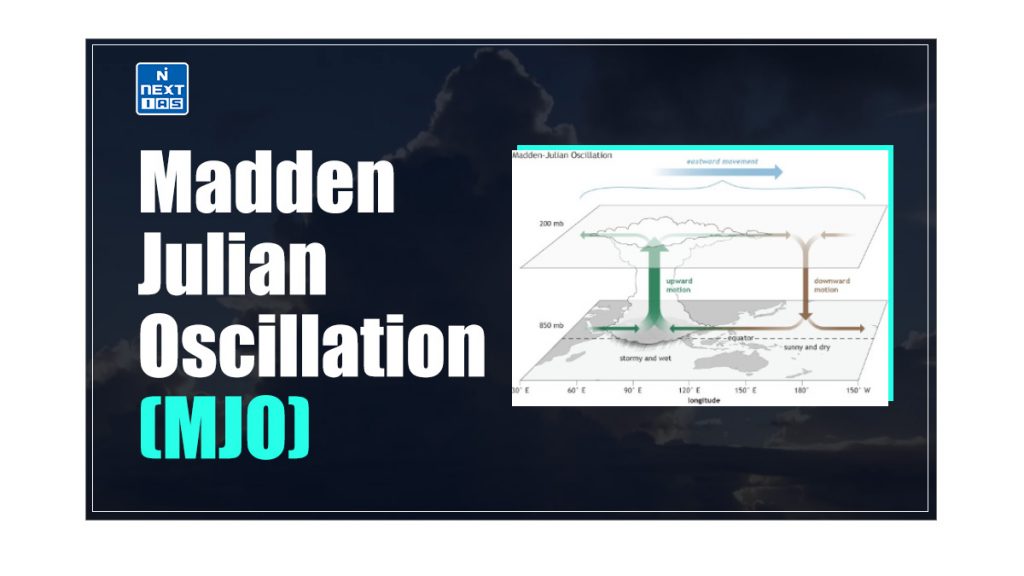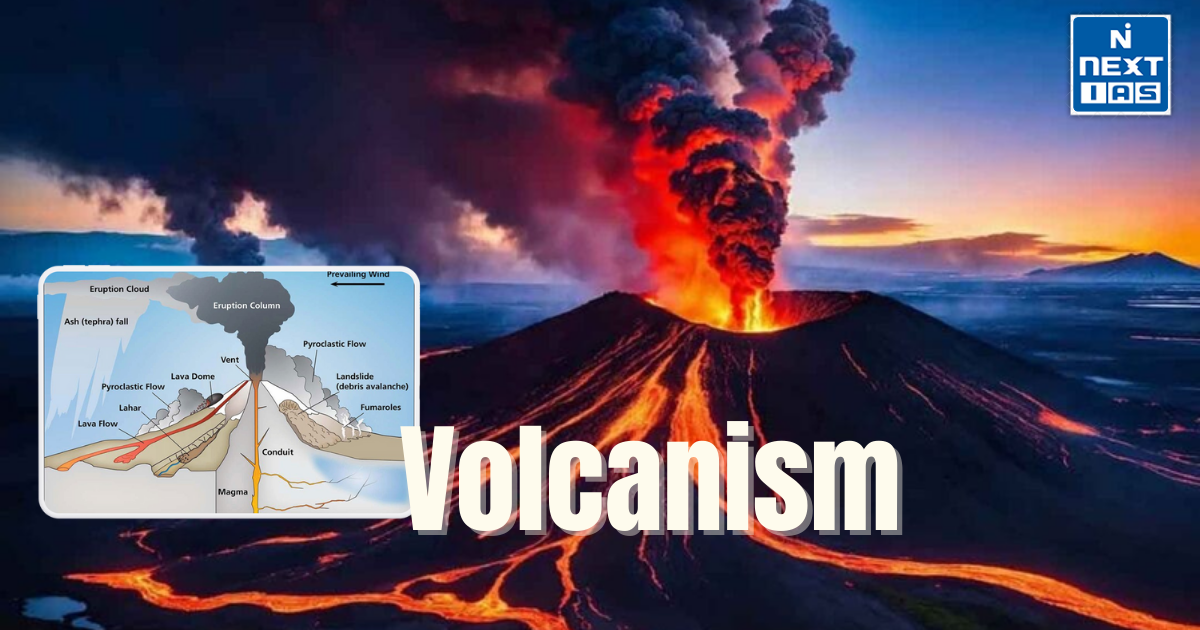
The Madden Julian Oscillation (MJO) is a prominent tropical climate pattern that involves the periodic movement of cloud and rainfall activity across the equator. It is significant for its role in modulating weather patterns globally, including influencing the strength and distribution of monsoons and cyclones. This article aims to study in detail the features, phases, and significance of the Madden-Julian Oscillation, as well as its effects on global and regional climate systems.
What is Madden Julian Oscillation?
- The Madden Julian Oscillation (MJO) is the most significant component of intra-seasonal variability in the tropical atmosphere, causing notable fluctuations in tropical weather over weekly to monthly time scales.
- This oceanic-atmospheric phenomenon impacts global weather patterns, influencing rainfall and storm activity across various regions.
Features of Madden Julian Oscillation
The features of the Madden Julian Oscillation are:
Eastward Movement
- The MJO is characterised by an eastward-moving ‘pulse’ of cloud, wind, and rainfall near the equator.
Recurrent Cycle
- The MJO typically recurs every 30 to 60 days.
Geographical Prominence
- The MJO is most prominent over the Indian and Pacific Oceans.
Impact on Weather
- The MJO influences tropical and subtropical weather patterns, affecting rainfall and storm activity.
Phases of the MJO
- The oscillation has distinct phases, each associated with weather patterns and cloud cover variations and precipitation variations.
Phases of Madden-Julian Oscillation
The Madden Julian Oscillation consists of two parts or phases. Intense Madden Julian Oscillation activity often divides the planet into two distinct regions: one experiencing the enhanced convective phase with increased rainfall and cloudiness and the other undergoing the suppressed convective phase with reduced precipitation and clearer skies.
Enhanced Rainfall (or Convective) Phase
- Winds converge at the surface, causing air to rise throughout the atmosphere.
- As the air ascends, it cools and condenses, increasing rainfall.
- At the top of the atmosphere, the winds then reverse direction.
Suppressed Rainfall Phase
- At the top of the atmosphere, winds converge, causing air to sink and then spread out at the surface.
- This downward movement warms and dries the air, leading to reduced rainfall.
- As air sinks from high altitudes, it warms and dries, suppressing rainfall.
- This entire dipole structure moves west to east with time in the Tropics, causing more cloudiness, rainfall, and even storminess in the enhanced convective phase and more sunshine and dryness in the suppressed convective phase.
Influence of the Madden-Julian Oscillation on the Indian Monsoon
- The Indian Ocean Dipole (IOD), El Nino, and MJO are all oceanic and atmospheric phenomena that affect weather on a large scale.
- IOD only pertains to the Indian Ocean, but the other two affect weather globally up to the mid-latitudes.
- While the Indian Ocean Dipole (IOD) and El Niño remain fixed in their respective positions, the Madden-Julian Oscillation (MJO) is a traversing phenomenon that progresses through eight phases.
- When the Madden Julian Oscillation is over the Indian Ocean during the monsoon season, it enhances rainfall across the Indian subcontinent.
- On the other hand, when it witnesses a longer cycle and stays over the Pacific Ocean, the Madden Julian Oscillation brings bad news for the Indian Monsoon.
- It is linked with enhanced and suppressed rainfall activity in the tropics and is very important for the Indian monsoonal rainfall.
Periodicity of Madden-Julian Oscillation
- If it is nearly 30 days, then it brings good rainfall during the Monsoon season.
- If it is above 40 days, then Madden Julian Oscillation doesn’t give good showers and could even lead to a dry Monsoon.
- The shorter the cycle of Madden Julian Oscillation, the better the Indian Monsoon.
- Simply because it then visits the Indian Ocean more often during the four-month-long period.
- Madden Julian Oscillation over the Pacific Ocean and an El-Nino are detrimental to Monsoon rains.
Significance of Madden-Julian Oscillation (MJO)
The Madden-Julian Oscillation (MJO) is significant for several reasons:
Monsoon Forecasting
- The Madden Julian Oscillation influences the timing and intensity of the Indian monsoon, helping meteorologists predict rainfall patterns and extreme weather events.
Climate and Weather Patterns
- It plays a crucial role in the global climate system by affecting tropical weather patterns, including cyclones and storm systems.
Drought and Flood Predictions
- Understanding the Madden Julian Oscillation can aid in predicting droughts and floods by providing insights into variations in precipitation.
Seasonal Weather Variability
- The Madden Julian Oscillation contributes to seasonal weather variability, impacting agricultural planning and water resource management.
Conclusion
In conclusion, the Madden Julian Oscillation (MJO) significantly affects weather patterns on a global scale by modulating rainfall and storm activity across the tropics. Its periodic movement and varying phases can either enhance or suppress rainfall, directly influencing the Indian monsoon and broader climatic conditions. Understanding the Madden Julian Oscillation behaviour is crucial for accurate weather forecasting, climate prediction, and managing the impacts of extreme weather events.
Frequently Asked Questions (FAQs)
What is Madden-Julian Oscillation (MJO)?
The Madden-Julian Oscillation (MJO) is a large-scale atmospheric phenomenon characterized by a moving pattern of enhanced and suppressed tropical rainfall. It travels eastward around the global tropics and typically recurs every 30 to 60 days.
How does Madden-Julian Oscillation affect India?
The Madden-Julian Oscillation (MJO) significantly affects India by influencing the Indian Monsoon System. When the MJO’s active phase is over the Indian Ocean, it enhances monsoon rainfall, leading to more robust and widespread precipitation. Conversely, when the MJO is in its suppressed phase, monsoon activity tends to weaken, resulting in reduced rainfall.






